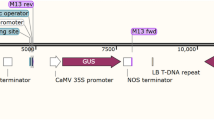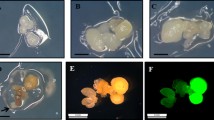Abstract
A tissue culture protocol, suitable for transformation, was established for the pasture grass Eragrostis curvula. Callus was generated in the dark from leaf and seed tissues on a medium comprising MS salts supplemented with 2 mg/l 2,4-D, 0.01 mg/l BAP and 2% sucrose. Plant regeneration occurred via organogenesis on the same medium with 6% and 3% sucrose for shoot and root formation, respectively. Optimal regeneration (50 plantlets per callus) occurred when light of 45 μmol/m2 per s was used. The yeast Saccharomyces cerevisiae Hsp12 gene was cloned into the Sac1 of the pCAMBIAUbeeQ vector and callus was transformed by biolistic bombardment. Best transformation (30%) occurred when the target tissue was bombarded twice at a distance of 70 mm using a bombardment pressure of 9,100 kPa. Although successful transformation and transcription of the Hsp12 gene occurred, no Hsp12 protein was found present in tissue extracts of transformed grass.



Similar content being viewed by others
Abbreviations
- BAP:
-
6-Benzylaminopurine
- 2.4-D:
-
2,4-Dichlorophenoxyacetic acid
- GUS:
-
β-Glucuronidase
- HSP:
-
Heat shock protein
- MS:
-
Murashige Skoog
- PCR:
-
Polymerase chain reaction
- TDZ:
-
Thidiazuron
- X-Gluc:
-
1-Bromo-2-chloro-3-indoyl-β-glucuronic acid
References
Chen W, Lennox S, Palmer K, Thomson JA (1998) Transformation of Digitaria sanguinalis: a model system for testing maize streak virus resistance in Poaceae. Euphytica 104:25–31
Chomczynski P, Sacchi N (1987) Single-step method of RNA isolation by acid guanidinium thiocyanate-phenol-chloroform extraction. Anal Biochem 162:156–159
Doyle JJ, Doyle JL (1990) Isolation of plant DNA from fresh tissue. Focus 12:13–15
Echenique V, Polci P, Mroginski L (1996) Plant regeneration in weeping lovegrass, (Eragrostis curvula) through inflorescence culture. Plant Cell Tissue Organ Cult 46:123–130
Farrant JM (2000) A comparison of mechanisms of desiccation tolerance among three angiosperm resurrection plant species. Plant Ecol 151:29–39
Gaff DF (1989) Responses of desiccation tolerant “resurrection” plants to water stress. In: Kreeb KH, Richter H, Hinckley TM (eds) Structural and function responses to environmental stress: water shortage. XIV International Botanical Congress, Berlin, pp 225–268
Klein TM, Wolf ED, Wu R, Sanford JC (1987) High velocity microprojectiles for delivering nucleic acid into living cells. Nature 327:70–73
Mtwisha L, Brandt W, McCready S, Lindsey GG (1998) Hsp12 is LEA-like protein in Saccharomyces cerevisiae. Plant Mol Biol 37:513–521
Murashige T, Skoog F (1962) A revised medium for rapid growth and bioassays with tobacco tissue culture. Physiol Plant 15:473–497
Roberts CS, Rajagopal S, Smith LA, Nguyen TA, Yang W, Nugroho S, Ravi KS, Cao M-L, Mijayachandra K, Patell V, Harcourt RL, Dransfield L, Desamero N, Slamet I, Keese P, Kilian A, Jefferson RA (1998) A comprehensive set of modular vectors for advanced manipulations and efficient transformation of plants by both Agrobacterium and direct DNA uptake methods. PCAMBIA vector release manual, version 3.05
Sales K, Brandt W, Rumbak E, Lindsey GG (2000) The LEA-like protein in Saccharomyces cerevisiae has a plasma membrane location and protects membranes against desiccation and ethanol-induced stress. Biochim Biophys Acta 1463:267–278
Sambrook J, Fritsch EF, Maniatis T (1989) Molecular cloning: a laboratory manual, 2nd edn. Cold Spring Harbour Laboratory Press, Cold Spring Harbour, N.Y.
Vander Willigen C, Pammenter NW, Mundree S, Farrant JM (2001) Some physiological comparisons between the resurrection grass, Eragrostis nindensis, and the related desiccation sensitive species, E. curvula. Plant Growth Regul 35:121–129
Acknowledgements
The authors thank Dr S. G. Mundree for donation of the pCAMBIAUbeeQ vector. The work was supported by a grant to Jill Farrant awarded by the National Research Foundation and the DST Innovation fund.
Author information
Authors and Affiliations
Corresponding author
Additional information
Communicated by A. Altman
Rights and permissions
About this article
Cite this article
Ncanana, S., Brandt, W., Lindsey, G. et al. Development of plant regeneration and transformation protocols for the desiccation-sensitive weeping lovegrass Eragrostis curvula. Plant Cell Rep 24, 335–340 (2005). https://doi.org/10.1007/s00299-005-0940-1
Received:
Revised:
Accepted:
Published:
Issue Date:
DOI: https://doi.org/10.1007/s00299-005-0940-1




